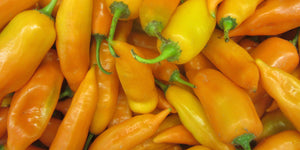The Aji Chilli Pepper
We’re talking about THE chilli pepper of Peru. Often it’s simply referred to as the Peruvian Hot Pepper to pay tribute to its role in many popular Peruvian dishes.
Scoville scale (SHUs) |
1,000 to 75,000 SHUs |
Claim to Fame |
The chilli or Peru |
First, let’s take a minute to appreciate Peruvian cuisine. For six years in a row, the country has been named as the ‘World’s Leading Culinary Destination’. With its diverse cuisine and rich range of ingredients, Peruvian meals have impressed people around the world.
Keeping this in mind, Aji is an important condiment of Peruvian cuisine. In fact, Peruvian Chef, Gaston Acurio, named the chilli as the most important ingredient in Peruvian cooking. It even goes as far as stating claiming this chilli as one of the Peruvian ‘holy trinity’, alongside garlic and red onion. So if the Aji chilli is a central ingredient to the best food of the world, it must truly be working marvels.
How hot are we talking?
The Aji ranges from 1000 - 75,000 Scoville Heat Units (SHUs). While this seems miniscule in comparison to the 2,000,000 SHU of the Carolina Reaper, the hottest variant of the Aji is still six times hotter than the jalapeño, so it shouldn’t be taken lightly for anyone unpracticed in the world of spice. However, the heat is short lived with, with no lasting pain, making it such a popular addition to many fresh meals.
Types of Aji
The most commonly used Aji is the Aji Amarillo, translating to Yellow Chilli. Despite its name, the chilli has matured once it has turned orange and cooked will add a fruity taste to the meal. On the Scoville scale, the Aji is a moderate to low heat, ranking from 30,000 to 50,000 SHUs.
Coming from Perú’s northern coastal valleys, the Aji Norteño adds a slight sweet and fruity flavour. It ranges from 1000 - 5000 Scoville units so has relatively low heat. This make it a good addition to fresh seafood meals, such as the renounced Peruvian dish Ceviche.
The Ají Panca, the Peruvian Red Pepper, is a sweet, smokey variety of the Ajis, often compared to the flavour of a berry. It is best used dried or in a paste, which you can find in Latin Food stores. This is another mild version of the Aji types, ranking at 1000 - 5000 SHUs and works as a great seasoning for chicken and beef.
The Aji Limon, also known as the Lemon Drop Pepper, it is a slightly hotter chilli in the variety. Ranging from 15,000 - 30,000 SHUs it not only adds heat, but also tang, much like a lemon. So if you’re after a citrus flavoured spice, this is the best addition to the meal. Ideally it compliments chicken, seafood and any fruit-based salsas.
If you’re looking for a hotter variety, the Aji Charapita ranging from 30,000 - 50,000 SHUs will add a hot fruity kick to the meal. Found in the middle of the jungle in northern Perú, not only is it hard to find but also expensive to buy. It is claimed to be the most expensive chilli you can buy. But if you have it in your hand, it’s a good spice for rice dishes and of course your fish and chicken.
How to use the Aji Chilli?
Most of the variants lead to the same answer: add the Aji to chicken and fish. In general the fruity and citrus based nature of the Aji chilli is great for any fresh meal. Yet more specifically, most of these chillies make for a great paste and salsa. Whether it’s the Aji Amarillo Sauce, the Aji Panca Paste or the Aji Lemon and Mango Sauce, they can be slathered over a grilled chicken, added as seasoning or placed on the side of the a seafood dish.
To find out more about other chilli favourites
| 7 Pot Chilli | Read the blog | Explore the range |
| Aji Chilli | Read the blog | Explore the range |
| Bhut Jolokia (Ghost Chilli) | Read the blog | Explore the range |
| Birdseye | Read the blog | Explore the range |
| Carolina Reaper | Read the blog | Explore the range |
| Cayenne | Read the blog | Explore the range |
| Fatalii | Read the blog | coming soon |
| Habanero | Read the blog | Explore the range |
| Jalapeño | Read the blog | Explore the range |
| Naga Viper | Read the blog | Explore the range |
| Piri Piri | Read the blog | coming soon |
| Scotch Bonnet | Read the blog | Explore the range |
| Trinidad Scorpion | Read the blog | Explore the range |

